|
Clematis can be affected
by many pests, and diseases but should not be regarded
as difficult plants. Careful attention to planting
and subsequent cultivation will produce vigorous
plants capable of surviving most pest and disease
attacks and avoiding disorders.
Most of the following extracts are taken from
the BCS Fact Sheet on this subject and cover common
problems. Consult the leaflet for a more comprehensive
coverage or login to the members section.
Pests
- Aphids
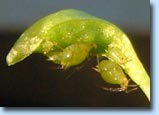 Various greenfly and blackfly attack clematis,
especially during spring and early summer. Heavy
infestations at the shoot tips can stunt growth
and soil foliage with a sugary, sticky excrement
known as 'honeydew'. Black, sooty moulds can develop
in this substance. Check new growth for aphids
and, if necessary, spray with an appropriate pesticide
or alternatively attract aphid predators such as
ladybirds. Various greenfly and blackfly attack clematis,
especially during spring and early summer. Heavy
infestations at the shoot tips can stunt growth
and soil foliage with a sugary, sticky excrement
known as 'honeydew'. Black, sooty moulds can develop
in this substance. Check new growth for aphids
and, if necessary, spray with an appropriate pesticide
or alternatively attract aphid predators such as
ladybirds.
- Caterpillars
 Most caterpillar damage occurs on new growth
in the spring. The culprits are usually caterpillars
of the angleshades moth or the lesser yellow underwing.
Both emerge to feed at night, eating leaves down
to stalks and boring into developing flower buds.
Hand picking by torchlight on mild evenings can
reduce infestations, otherwise spray with an appropriate
pesticide. Most caterpillar damage occurs on new growth
in the spring. The culprits are usually caterpillars
of the angleshades moth or the lesser yellow underwing.
Both emerge to feed at night, eating leaves down
to stalks and boring into developing flower buds.
Hand picking by torchlight on mild evenings can
reduce infestations, otherwise spray with an appropriate
pesticide.
- Earwigs
 Earwigs hide by day and emerge at dusk to eat
ragged holes in the leaves and flower petals. Plants
grown against fences or walls are at increased
risk because the supporting structure provides
many daytime hiding places. Some earwigs can be
trapped by placing flowerpots loosely stuffed with
hay on the end of bamboo canes near the clematis
- they are then removed and destroyed during the
day. Heavy infestations may need spraying at dusk
with an appropriate pesticide. Earwigs hide by day and emerge at dusk to eat
ragged holes in the leaves and flower petals. Plants
grown against fences or walls are at increased
risk because the supporting structure provides
many daytime hiding places. Some earwigs can be
trapped by placing flowerpots loosely stuffed with
hay on the end of bamboo canes near the clematis
- they are then removed and destroyed during the
day. Heavy infestations may need spraying at dusk
with an appropriate pesticide.
Leaf Miner
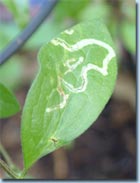 The
larvae of the leaf miner fly, tunnel between the
layers of the leaf causing a whiteish brown tunnel
that winds its
way around the leaf usually ending in a larger
blotch. They do not usually cause any stunting
to the plant although if left to get out of hand
can make the plant look a bit unsightly. In the
early stages you can pinch the larger brown blotches
(usually at the end of the trail) and kill the
larvae or alternatively cut off the leaf and burn
it. If getting out of hand I believe there are
insecticides on the market that can be used to
control the spread of these creatures. The
larvae of the leaf miner fly, tunnel between the
layers of the leaf causing a whiteish brown tunnel
that winds its
way around the leaf usually ending in a larger
blotch. They do not usually cause any stunting
to the plant although if left to get out of hand
can make the plant look a bit unsightly. In the
early stages you can pinch the larger brown blotches
(usually at the end of the trail) and kill the
larvae or alternatively cut off the leaf and burn
it. If getting out of hand I believe there are
insecticides on the market that can be used to
control the spread of these creatures.
Rabbits and Mice
- Rabbits will bite off young shoots of herbaceous
clematis or sever the stems of taller plants. Mice
climb up the stems to eat the shoot tips and flower
buds. In rabbit-infested gardens it may be necessary
to put wire netting aroung the plants. Mice are
more difficult to combat, but setting mouse traps
under the corner of logs or bricks may help.
Red Spider Mite
- These usually attack
plants inside the greenhouse although they
can be found outside in dry hot weather. The
mites are very small and are not usually noticed
until their fine webbing becomes obvious. They
eventually cause the leaves to become mottled
before becoming brittle and dropping off. They
can be controlled by weekly sprays of
insecticide, the introduction of a predatory
mite (Phytoseiulus persimilis) or alternatively
increase the humidity in the surrounding area.
-
- Scale
 Scale have been a relatively dormant pest over
the last decade, but as the climate warms up and
the summers get hotter so these insects are making
a comeback. They infest clematis planted in hot
sunny positions where they attach themselves to
the stems or the undersides of leaves. From these
positions they can feed on the rising sap within
the plant. Scale have been a relatively dormant pest over
the last decade, but as the climate warms up and
the summers get hotter so these insects are making
a comeback. They infest clematis planted in hot
sunny positions where they attach themselves to
the stems or the undersides of leaves. From these
positions they can feed on the rising sap within
the plant.
Like aphids they cannot process all
the goodness within the sap and the excess is passed
out as honeydew, which again, like aphids, attract
ants. These insects have a somewhat shiny protective
coating which can help protect it from externally
sprayed insecticides but it cannot cope with
systemic types.
- Slugs and snails
 Slugs
and snails are nocturnal (most active at night)
creatures and this is when they do the most damage.
A variety of methods can be used to combat slugs
and snails, some of which are: surrounding the
base of plants with fine grit or broken egg shells;
smearing vaseline around the rims of flowerpots;
using plastic 'collars' made from 2 litre soft
drink bottles as a barrier. Probably most effective
is a midnight troll through the garden with a flashlight,
collecting and disposing of all slugs and snails
that you find. Slugs
and snails are nocturnal (most active at night)
creatures and this is when they do the most damage.
A variety of methods can be used to combat slugs
and snails, some of which are: surrounding the
base of plants with fine grit or broken egg shells;
smearing vaseline around the rims of flowerpots;
using plastic 'collars' made from 2 litre soft
drink bottles as a barrier. Probably most effective
is a midnight troll through the garden with a flashlight,
collecting and disposing of all slugs and snails
that you find.
- Vine Weevil
 These
insects in their adult form look like medium sized
black beetles and can normally be found residing
on or under leaves which they feed on leaving
what looks like an irregular bite. This probably
will do little harm to the plant but it is the
eggs and associated larvae that they lay in the
soil by the roots that do the damage. The
larvae have a voracious appetite for roots
and you will not know your plant has a problem
until it wilts and dies. These
insects in their adult form look like medium sized
black beetles and can normally be found residing
on or under leaves which they feed on leaving
what looks like an irregular bite. This probably
will do little harm to the plant but it is the
eggs and associated larvae that they lay in the
soil by the roots that do the damage. The
larvae have a voracious appetite for roots
and you will not know your plant has a problem
until it wilts and dies. 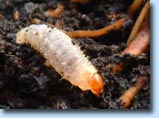 They can be a real
problem if you grow plants in containers where
they are most likliest to be found. There is now
some control products available on the market
including nematodes. The adult weevil cannot fly
so if you have a greenhouse then it is a good idea
to grease the pillars as this stops the weevils
climbing onto any raised benches. They can be a real
problem if you grow plants in containers where
they are most likliest to be found. There is now
some control products available on the market
including nematodes. The adult weevil cannot fly
so if you have a greenhouse then it is a good idea
to grease the pillars as this stops the weevils
climbing onto any raised benches.
- Whitefly
- These insects are only
usually a pest to plants grown in greenhouses
although they do occasionally attack outside
plants.
They generally do little damage as they usually
arrive too late in the season to do any great
harm. They can be controlled by insecticides
but due to their short life cycle you must spray
at least three times in periods of less than
one week.
-
- Diseases
- Slime flux
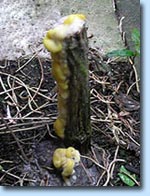 When woody stems are injured, bacteria which
normally live on the surface of the bark can gain
entry to the deeper wood. In spring, when temperatures
and root pressure increase, the bacteria multiply
rapidly and are forced out of the wounds with the
rising sap as a nasty-smelling, slimy ooze. The
condition is often fatal above the entry wound
but if the plant is cut off below the affected
area it will sometimes regrow. There is no chemical
treatment. When woody stems are injured, bacteria which
normally live on the surface of the bark can gain
entry to the deeper wood. In spring, when temperatures
and root pressure increase, the bacteria multiply
rapidly and are forced out of the wounds with the
rising sap as a nasty-smelling, slimy ooze. The
condition is often fatal above the entry wound
but if the plant is cut off below the affected
area it will sometimes regrow. There is no chemical
treatment.
Powdery mildew
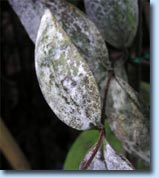 Clematis are very prone to infection by powdery
mildews, especially under conditions of water stress.
The disease only affects leaves and young stems
where it is unsightly but not fatal. Avoid water
stress and treat infections with an appropriate
fungicide. Clematis are very prone to infection by powdery
mildews, especially under conditions of water stress.
The disease only affects leaves and young stems
where it is unsightly but not fatal. Avoid water
stress and treat infections with an appropriate
fungicide.
Clematis wilt
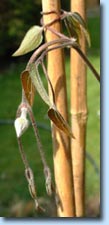 This is the most important disease of clematis.
Large-flowered varieties vary in their susceptibility
whilst small-flowered forms are mostly resistant.
Clematis wilt is caused by infection with a fungus
which results in the sudden wilting and collapse
of the upper parts of the plant. The plant can
sometimes be saved by cutting back below the level
of infection - even if this means cutting it down
to ground level. The infected material should be
carefully removed because the fungus can live in
it for many months. There is no chemical treatment
available to amateur gardeners. This is the most important disease of clematis.
Large-flowered varieties vary in their susceptibility
whilst small-flowered forms are mostly resistant.
Clematis wilt is caused by infection with a fungus
which results in the sudden wilting and collapse
of the upper parts of the plant. The plant can
sometimes be saved by cutting back below the level
of infection - even if this means cutting it down
to ground level. The infected material should be
carefully removed because the fungus can live in
it for many months. There is no chemical treatment
available to amateur gardeners.
Wilt is usually blamed for any and all collapsed
clematis - experts at the Royal Horticultural
Society note that it is actually relatively
rare. There are many other causes of collapsed
plants.
Adapted and abridged from BCS Fact Sheet
No. 6 Pests, Diseases and Disorders of
Clematis prepared for the Society by members
of the RHS Advisory Service
| Top
of Page | Home Page | © 2007
British Clematis Society |













